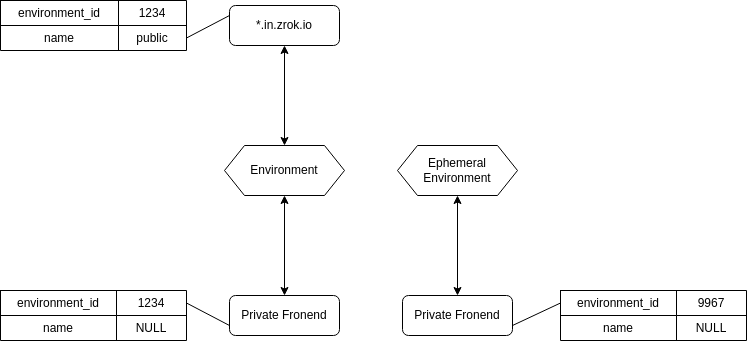4.6 KiB
v0.3 Public/Private Sharing
The v0.3 series introduces new sharing modes, and new types of built-in services.
Share Modes
Note: In v0.3, the tunnel and untunnel concepts get renamed to share and unshare.
Note: We're going to continue using frontend and backend as concepts, even though those words will be changing in the zrok CLI. A frontend will continue to describe an "ingress" into the zrokservice, and is the tool that is used by the user "consuming" or serve-ing the the zrok service. A backend will continue to describe the "binding" created by a user that wants to share a resource.
Public Sharing
In v0.2, zrok only offered a "public" sharing mode. The public sharing mode will allow any configured frontend instances to send traffic to any backend. The policy and permission model was very simple and flat. A v0.2 deployment considers any available frontend instance to be allowed to send traffic to configured services. The access for frontend instances is controlled by identity provisioning within the underlying Ziti network.
In v0.3, zrok will offer both a "public" and a "private" sharing mode. When v0.3 configures the policies for a service, a publicly-shared service will have policies created that allow whichever selected public frontend instances to access the shared backend. A v0.3 deployment will have a collection of multi-tenant, high-capacity frontend instances available to be selected from. The zrok CLI will default to selecting the public frontend instances.
The frontend selection approach also gives us a clean implementation for picking public frontend instances based on geography (either network or physical). The production zrok.io service could easily offer multiple different fleets of frontend instances, and this mechanism will allow backend users to choose where they want to offer access to their service.
Private Sharing
v0.3 introduces a "private" sharing mode. When provisioning a service for private sharing, zrok will not create any policies for the service, until a request for a frontend binding is created for the service (through the v0.3 zrok serve command).
The v0.3 zrok API will support creating frontend instances for both identified users (where the zrok user has a provisioned environment), as well as ephemeral users (the zrok controller will create a single-use "ephemeral environment" for these frontend instances).
Backend Modes
In v0.2, the only possible backend "mode" was used for reverse proxying HTTP traffic to a local endpoint. The v0.3 zrok client will support several different backend modes, providing a number of built-in conveniences.
Web Mode
A user has a collection of files on disk. Sharing with a backend mode of "web", will create a backend that shares a file tree as if it were a local web server. This effectively allows a user to bind a web-server backend to a document root with a single CLI command.
DAV Mode
A user wants to operate a read/write repository of files accessible through either conventional WebDAV clients (through public frontend instances), or through the zrok CLI (a convenience wrapper, embedding WebDAV capabilities).
This allows users to create read/write repositories of files that can be shared with multiple users, and also allows for the creation of write-only "drop boxes" for receiving files from another user (often a tricky thing to do well and securely on the public internet).
Proxy Mode
v0.3 will retain the classic reverse proxy mode, as well. Will continue to allow a user to expose a local HTTP endpoint through zrok.
Entities (SQL)
v0.3 introduces a new frontends table to allow the zrok controller to track the frontend instances that are available to any account or environment.
The following illustration shows the possibilities available.
The *.in.zrok.io frontend is a "public" frontend, available to all zrok users. Most zrok installations will want to have at least one public, global frontend for all public, internet-facing ingress traffic for private backend instances. In the underlying data store, the public frontend will have a name set to public (or some other representative name), allowing users to reference that frontend using a friendly label.
The other two "private" frontends are configured with no name label (the lack of a name label signifies that these are "private" frontends). The ephemeral environment is allocated when a zrok frontend request is made without an account on behalf of a private share.
